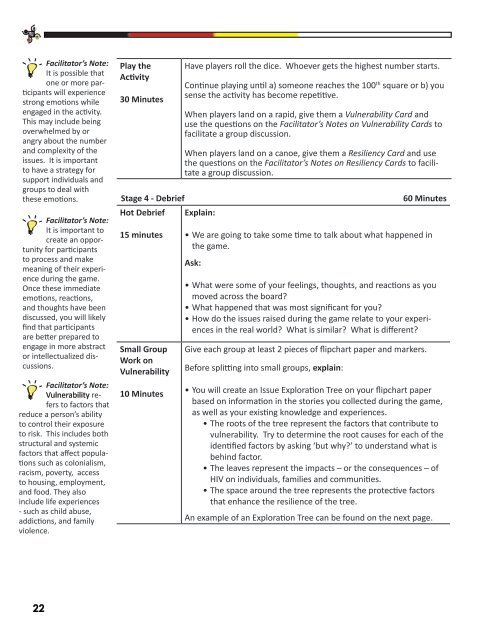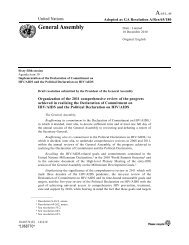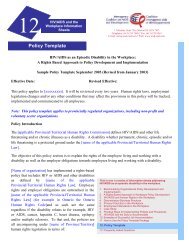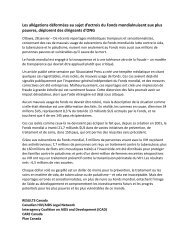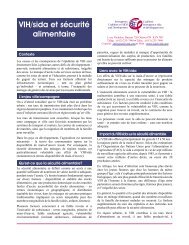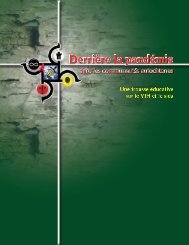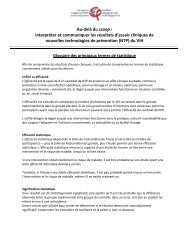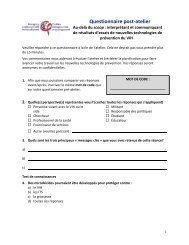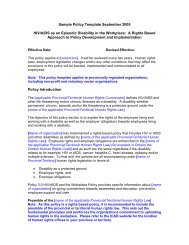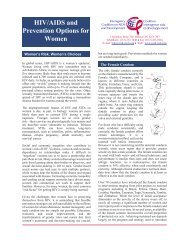Behind the Pandemic in Aboriginal Communities - Interagency ...
Behind the Pandemic in Aboriginal Communities - Interagency ...
Behind the Pandemic in Aboriginal Communities - Interagency ...
- No tags were found...
Create successful ePaper yourself
Turn your PDF publications into a flip-book with our unique Google optimized e-Paper software.
Facilitator’s Note:It is possible thatone or more participantswill experiencestrong emotions whileengaged <strong>in</strong> <strong>the</strong> activity.This may <strong>in</strong>clude be<strong>in</strong>goverwhelmed by orangry about <strong>the</strong> numberand complexity of <strong>the</strong>issues. It is importantto have a strategy forsupport <strong>in</strong>dividuals andgroups to deal with<strong>the</strong>se emotions.Facilitator’s Note:It is important tocreate an opportunityfor participantsto process and makemean<strong>in</strong>g of <strong>the</strong>ir experiencedur<strong>in</strong>g <strong>the</strong> game.Once <strong>the</strong>se immediateemotions, reactions,and thoughts have beendiscussed, you will likelyf<strong>in</strong>d that participantsare better prepared toengage <strong>in</strong> more abstractor <strong>in</strong>tellectualized discussions.Facilitator’s Note:Vulnerability refersto factors thatreduce a person’s abilityto control <strong>the</strong>ir exposureto risk. This <strong>in</strong>cludes bothstructural and systemicfactors that affect populationssuch as colonialism,racism, poverty, accessto hous<strong>in</strong>g, employment,and food. They also<strong>in</strong>clude life experiences- such as child abuse,addictions, and familyviolence.Play <strong>the</strong>Activity30 M<strong>in</strong>utesStage 4 - DebriefHot Debrief15 m<strong>in</strong>utesSmall GroupWork onVulnerability10 M<strong>in</strong>utesHave players roll <strong>the</strong> dice. Whoever gets <strong>the</strong> highest number starts.Cont<strong>in</strong>ue play<strong>in</strong>g until a) someone reaches <strong>the</strong> 100 th square or b) yousense <strong>the</strong> activity has become repetitive.When players land on a rapid, give <strong>the</strong>m a Vulnerability Card anduse <strong>the</strong> questions on <strong>the</strong> Facilitator’s Notes on Vulnerability Cards tofacilitate a group discussion.When players land on a canoe, give <strong>the</strong>m a Resiliency Card and use<strong>the</strong> questions on <strong>the</strong> Facilitator’s Notes on Resiliency Cards to facilitatea group discussion.Expla<strong>in</strong>:60 M<strong>in</strong>utes• We are go<strong>in</strong>g to take some time to talk about what happened <strong>in</strong><strong>the</strong> game.Ask:• What were some of your feel<strong>in</strong>gs, thoughts, and reactions as youmoved across <strong>the</strong> board?• What happened that was most significant for you?• How do <strong>the</strong> issues raised dur<strong>in</strong>g <strong>the</strong> game relate to your experiences<strong>in</strong> <strong>the</strong> real world? What is similar? What is different?Give each group at least 2 pieces of flipchart paper and markers.Before splitt<strong>in</strong>g <strong>in</strong>to small groups, expla<strong>in</strong>:• You will create an Issue Exploration Tree on your flipchart paperbased on <strong>in</strong>formation <strong>in</strong> <strong>the</strong> stories you collected dur<strong>in</strong>g <strong>the</strong> game,as well as your exist<strong>in</strong>g knowledge and experiences.• The roots of <strong>the</strong> tree represent <strong>the</strong> factors that contribute tovulnerability. Try to determ<strong>in</strong>e <strong>the</strong> root causes for each of <strong>the</strong>identified factors by ask<strong>in</strong>g ‘but why?’ to understand what isbeh<strong>in</strong>d factor.• The leaves represent <strong>the</strong> impacts – or <strong>the</strong> consequences – ofHIV on <strong>in</strong>dividuals, families and communities.• The space around <strong>the</strong> tree represents <strong>the</strong> protective factorsthat enhance <strong>the</strong> resilience of <strong>the</strong> tree.An example of an Exploration Tree can be found on <strong>the</strong> next page.22


